In September of 2015, scientists at the University of Witwatersrand, led by Dr. Lee Berger, made a bombshell announcement. Not only had a new species of hominin been discovered, but the find contained more than 1500 fossils from at least 15 individuals. The remains were found all in one place, a deep dark cave in South Africa. This was, by far, the largest number of fossils ever found in one place in the history of paleoanthropology. In one fell swoop, Homo naledi went from being completely unknown to science to being one of the most fully described hominins ever. Although no age was given to the fossils at the time, speculation was rampant.
Over the last few months, the paleoanthropology community has been abuzz with rumors that more H. naledi fossils had been found and that the age of the fossils had been determined. On May 9th, a large team of scientists, again led by Berger, confirmed the rumors and made two big announcements regarding this enigmatic species. First, a second cave had been found harboring more H. naledi skeletal remains. Second, and even more dramatically, the dating effort from the original fossil find revealed that the fossils are much younger than previously thought, a mere 300,000 years old.
The results are released in three papers in the journal eLife, published by the Howard Hughes Medical Institute, which was also the venue for the first publication of Homo naledi in 2015. Both of these announcements have astounding and far-reaching implications. A couple days before the press conference, I caught up with Lee Berger to ask him what all this means.
The Second Cave
The second cavern, called the Lesedi chamber, is a mere 80 lateral meters from the now-famous Dinaledi chamber, which housed the treasure trove of fossils announced in 2015. That find remains the largest hominin discovery in history with enough fossils to nearly recreate the entire skeleton. Both the Dinaledi and Lesedi chambers are within the Rising Star cave system in the UNESCO World Heritage Site called The Cradle of Humanity.
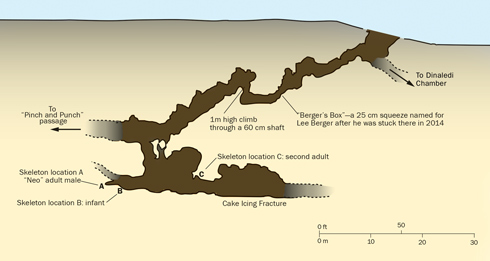
The Lesedi chamber. (Illustration by Pat Linse, adapted from a drawing on washington.edu.) Click image to enlarge.
The Lesedi chamber contains fewer fossils than were in Dinaledi. However, while the Dinaledi fossils were all mixed in together, Lesedi harbored partial skeletons corresponding to three distinct individuals, two adults and an infant. One skeleton, called Neo, is nearly as complete as the famous “Lucy” skeleton, the type specimen of Australopithecus afarensis.
The remarkably complete skull of Neo adds additional information about the anterior skull and face. For example, we now know that the nose and maxillary area of H. naledi is flatter than previously thought. “Hopefully this puts the argument that this is Homo erectus to rest!” said Berger, a reference to the small but vocal contingent of those that believe that H. naledi is nothing more than a primitive H. erectus.
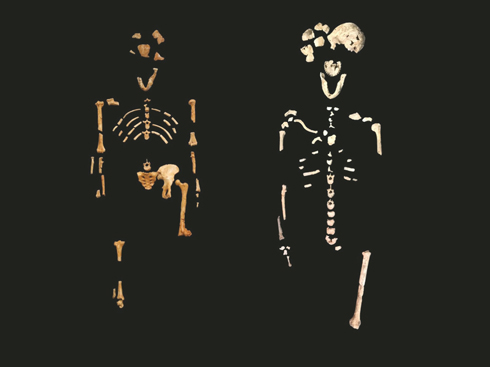
Left: A. afarensis (Lucy). Right: H. naledi (Credit: Wits University/John Hawks). Click image to enlarge.
Both of these “burial chambers” are in the same cave system and both are incredibly difficult to access. All assumptions are that the hominins in both chambers were contemporaries, but the age of the new fossils is not yet known. Dating will require that some fossils be destroyed in the process and Berger insists on publishing the fossils first and making them available to the community via Morphosource before any of the samples are consumed for the dating efforts. As I wrote in Skeptic last year, the H. naledi team has displayed an unprecedented commitment to transparency and the democratization of science, believing that fossils belong to no one and should be shared freely and widely.
A Surprising Young Age
When H. naledi was first announced, many assumed that the fossils were between two and three millions years old. The unique and surprising combination of primitive and advanced features places this species at or near the base of the Homo family tree. The tiny brain and curved fingers, for example, are primitive characteristics within the hominin lineage, but the heel made for striding, the proximal femur, and the shoulders are clearly derived features for the Homo clade. (A clade that needs some revision, by the way.)
We now have an essentially complete skeleton that harbors an interesting but confusing mosaic of primitive and derived characteristics.
Based on the anatomical features, most agree that H. naledi is an early species of the Homo genus, so the tender young age of 300,000 years is quite a surprise. While there are several possibilities, what seems most likely is that this hominin was a long-persisting species. It evolved somewhere in Africa, possibly from a common ancestor of H. habilis or even from habilis itself. For comparison, H. erectus was also a long-persisting species, but it was more advanced than H. naledi, spread throughout Asia but not much in Africa except its earliest beginnings, and showed a steady increase in brain size over the life of the species. H. naledi seems to be more in the style of H. floresiensis, the “hobbits” discovered in 2003 at Liang Bua on the island of Flores in Indonesia, who maintained a primitive hominin form until surprisingly recent times. The hobbits had the benefit of isolation on a Pacific island, however, while H. naledi lived in the aptly named cradle of humanity amidst several lineages of hominins, including our own.
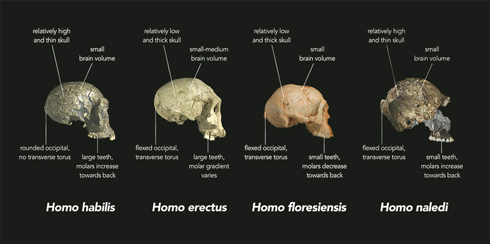
Credit: Chris Stringer/eLife. Click image to enlarge.
Whether or not H. naledi was long-persisting or evolved more recently from some ancestor waiting to be discovered, this adds yet another lineage of hominins roaming through the Southern half of Africa during the Pleistocene and late Pliocene epochs.
The Importance of the Body Skeleton
One of the most important lessons gleaned from the bones of Homo naledi is that attempts to infer ancestry from isolated bones, fragments, or dentition must be viewed with a grain of salt. The history of paleoanthropology is filled with tall tales woven from the fragments of a mandible, a single tooth, or a piece of skull. As Donald Prothero told me when we were discussing one of his books two years ago, “That would never fly in any other field of Paleontology, but when it comes to the hominin fossil record, it’s us that we’re talking about, so the rules get bent a little bit in our desperate desire to understand our origins.”
With these two big discoveries of H. naledi and other recent finds including H. floresiensis from Indonesia, the Dmanisi skulls from Georgia, and the Sima de los Huesos site in Spain, paleoanthropology has a lot more material on which to base our still-murky understanding of our evolutionary origins. As Berger told me, “It used to be joked that paleoanthropology had more practitioners than fossils, but finally that’s not true anymore!” The power of having so many H. naledi fossils cannot be overstated. We now have an essentially complete skeleton that harbors an interesting but confusing mosaic of primitive and derived characteristics.
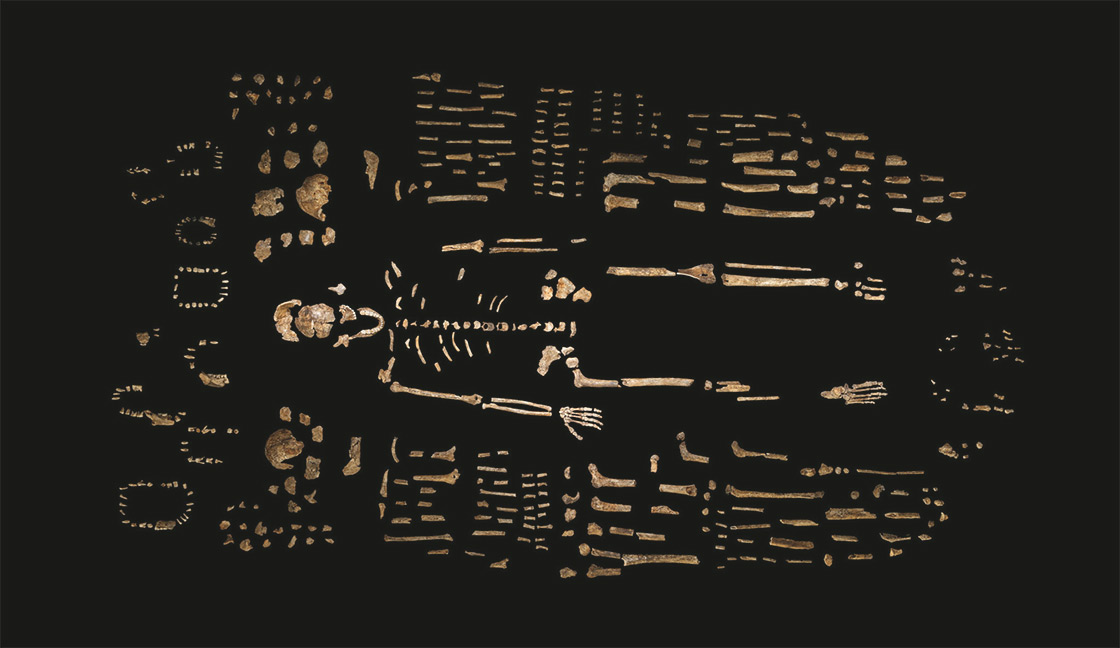
Composite skeleton of Homo naledi, surrounded by fossil fragments. (Credit: Robert Clark/National Geographic, Lee Berger/Wits University). Click image to enlarge.
“The phylogeny works out very differently based on which anatomy you consider,” says Berger, a point made very clear in an accompanying paper discussing how H. naledi fits into the rich hominin diversity of subequatorial Africa. Looking only at the skull, H. naledi looks primitive indeed and this is why having the postcranial skeleton is so important. In addition, by having so many individuals, we also gain a sense of the interpersonal variation in their anatomy. From even just the first cave, we now have more fossils of H. naledi than we do of any other extinct hominin, except Neanderthal and erectus.
Big Implications for Archaeology
When I inquired as to the largest impact that might not be immediately obvious, Berger replied, “The field that will be most impacted by the young age of H. naledi may actually be archaeology!” This is because, previously, stone tools that were found anywhere in Southern Africa dating to the middle or late Pleistocene were attributed to the coastal populations of archaic Homo sapiens. By the last half-million years, there were no other hominins in Southern Africa except our lineage. Or so we thought.
It is not known whether H. naledi crafted tools. When asked if any artifacts had been found in the caves, Berger demurred but did not issue a definitive “no.” While the small brain of H. naledi might make it seem unlikely to be a stone tool-maker, recall that two million-year old Homo habilis remains are associated with simple stone tools and their brains were only slightly bigger than those of H. naledi. It is also worth noting that the long fingers of H. naledi are ideal for fine handiwork.
Further still, size is only a crude measure of the power of a brain. After all, our own brains have shrunk by 10% since the last ice age. Analysis of the H. naledi skull has provided evidence that their brains may have undergone substantial organization and specialization like the brains of our immediate ancestors did. Because of how energy-hungry brains are, adaptations that allow greater efficiency and computing power without growing larger would be heavily favored. With this in mind, it is wise not to underestimate the brain power of the diminutive H. naledi.
More Evidence for Deliberate Body Disposal
Perhaps the most controversial and interesting feature of the H. naledi discovery is the manner in which the remains have been found. The two caves contain homogeneous collections of this single species. The only other fossilized remains are those of an owl and a few small scavenger mammals that found their way into the caves. Such mono-specific collections of remains are most unusual in paleontology, even unheard of, except in the case of a sudden catastrophe like a volcanic eruption. In these two caves, there are many individuals of the same species, with no other species present, collected in a tight space that is extremely inaccessible. This is remarkable and calls out for an explanation.
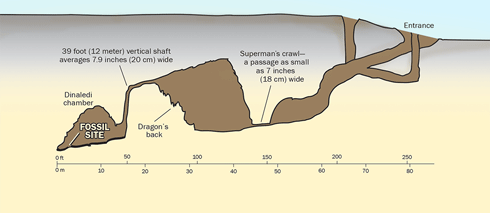
The Rising Star Cave System, showing access to the Dinaledi chamber. (Credit: Illustration by Pat Linse, based on image by National Geographic.) Click to enlarge image.
From the first announcement of the Dinaledi chamber in 2015, the possibility of intentional body disposal has hung in the air. On the one hand, the evidence is circumstantial and it may be impossible to ever know for sure. On the other hand, no alternative explanations supported by evidence have emerged in the last 18 months, and surely not from lack of attention. “It’s getting harder and harder to deny that the only reason we have a hard time accepting [the notion of intentional body disposal] is because we just don’t want to,” says Berger. Indeed, the idea that an otherwise primitive hominin might have developed enough social complexity to care about disposing of their dead is jarring, to say the least.
Even among those who agree that deliberate disposal is the most likely explanation, there is disagreement about whether this implies great social complexity. If a population was firmly rooted to a specific location, disposal of decomposing bodies could have become a simple “housekeeping” behavior to keep the area free of decaying bodies. One problem with this idea is that sedentary homesteading is not a lifestyle found in any primates except fully modern humans.
In these two caves, there are many individuals of the same species, with no other species present, collected in a tight space that is extremely inaccessible. This is remarkable and calls out for an explanation.
Further, the chambers are very far from the cave opening. Even if simply tossing a dead body down a hole doesn’t require much intelligence or social complexity, that’s not what occurred with these H. naledi collections. To reach either of the caves, one must traverse 60–70 lateral meters and descend almost as many vertical meters of treacherous terrain, in complete darkness. Both caves require passage through gauntlets, extremely narrow passages of 18cm and 25cm, respectively, at their narrowest point. Most humans cannot fit through these passages and Berger himself got stuck for some time in 2014. Geologists are quite confident that the caves were no more accessible 300,000 years ago than they are today. Whoever put those H. naledi bodies in those caves went to great lengths to do so. This makes little sense if the only goal was getting rid of a rotting corpse.
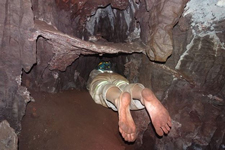
Dr. Hannah Hilbert-Wolf accessing the Dinaledi chamber (Credit: Wits University) Click to enlarge image
Fire Lighting the Way
While most attention understandably focuses on the body disposal itself, not to be forgotten is that both chambers were well into the “dark zone” where whoever deposited those H. naledi bodies was working in the complete absence of light. This suggests, though indirectly, that Homo naledi had mastered the use of fire. How else but with torches could they have navigated the twists, turns, drops, and climbs of the rising star caves?
Acknowledging this, Berger confirmed that scientists are scouring the cave for signs of fire use and any other artifacts that might give clues as to how and why these remains ended up in the chambers.
Something tells me that the rising star caves haven’t given up all of their secrets yet. ![]()
About the Author

This article was published on May 10, 2017.







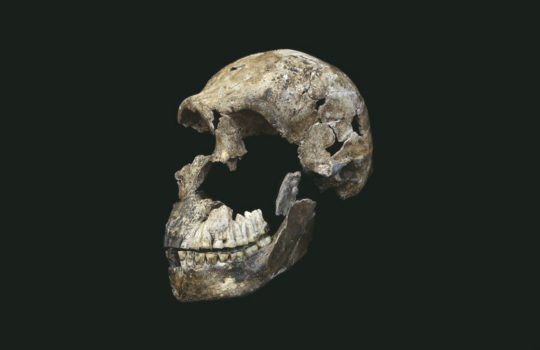








Naledi was no ho human ancestor & certainly it was no deliberate burial as prof.Berger believes: these are anthropocentrisms.
More likely it was natural fossilization of a wetland-dwelling ape (flattened feet, very curved handbones, small brain, generally bonobo-like), google e.g.
– bonobo waterlilies
– Pan naledi 2017 Verhaegen
– Attenborough Schagatay Brenna reply
Species-group names are not to be capitalized, even when a proper noun is used to form the name (see Appendix B of the ICZN). Capitalizing “afarensis” is redundant and it creates confusion among lay-readers.
Perhaps it was just a few wandering Homo Naledi who happened upon a hole in the ground and decided to investigate but got stuck. Or perhaps it was a hole in the ground that caused much fear, and a few unfortunates were sent to investigate. Or perhaps they were chasing a food source and got lost down there. Who knows? I think we jump to conclusions about fire use, purposeful burial, etc, too easily.
So, the extremities were more human like than the core. Could it be that an environment change, changed the extremities faster?
I must admit, the baseless ramblings by Tzindaro made my day! The Earth has no shape and goes on forever! What could possibly be the origin of this moronic conjecture? Has he not heard about astronauts?
As to the actual science at issue, I believe that ritual burial is more likely than accidental entrapment. Many cultures have gone to great lengths to entomb/honor at least some of their dead, although none as seemingly primitive as these. I hope there’s more evidence in the caves to settle the argument.
About burial and lighting, what if these creatures were fleeing attack and in fear they
went much further than ordinary into the recesses of the caves. Not being able to retrace their path death would have left them there.
Would you struggle with a heavy dead weight into confined darkness with a smoking torch?
I’m confused as to why they assume that they were bodies that got dumped, rather than living hominins that crawled in before dying. If there’s any evidence that makes that clear, I didn’t see it while reading the article.
I agree. I think maybe they crawled down there and got stuck. : (
Another speculation – if the ventilation in the cave is inadequate, perhaps a group went in just to explore, try to find the limit of the cave, as hominids seem to like to do; and then were overcome by hypoxia; and perhaps others went in to try to find them.
Very nice article!
Just one humble thought from someone outside this area: could it be that these hominids were trying to hide and got stuck?
I’m concerned about that cave. If the cavities were created by running water, that suggests other entrances/exits which may at one time have been more accessible. If there has been deposition of mineral materials such as we see in many limestone caverns, then the entrances may have been partially closed, or the matrix around the skeletons might prove to be younger than the bones themselves. I’m sure all these things have been considered, but given the description of the difficulties, I wonder if the caves have been as fully explored as possible.
@Tzindaro, spontaneous generation – LMAO!
And the skeptical point of the article was not accepting preliminary conclusions as shown by the surprising date which was not expected.
As to you other points – you’re funny. I hope your were trolling – if not sad!
Trolls don’t use that many key strokes.
You ask me, these ancient hominins already had a form of ritualistic burial practice. I definitely see no other explanation for the extraordinary locations of these skeletons. It has me wondering whether they might not already have had some form of ritualistic and even religious thinking about death. We definitely have to be careful not to sell our ancestors (or cousins of our ancestors, as the case may well be) short, especially if they’re from as recently as 300,000 years ago!
“Prehistory”, the term, implies we don’t know shit about what happened more than 10 millenia ago, especially when considering what few believers know what a millennium is. As for what evolution is, the people who do not understand it cannot even imagine what 100,000 years must be like. And a million years is sci-fi to them. They are missing the “big picture” marble, nowadays probably from birth because of modern medical and social science intervening in who survives to adulthood and who is born with the means to do so naturally. There is a a small plus to all of this, however, and that being how much fun it is to watch myth and science still dueling everything out only now in higher terms. PS: my own fetus was conceived without a soul, please do not hold that against me.
I was born during WWII, but I have no memory of it whatsoever. The earliest memory I can reliably put a date on is in 1948 when my youngest brother was born and he and my mother were brought home in the neighbor’s hearse (he was postmaster and undertaker) on a gurney. I believe it’s a memory, though I’ve begun to doubt some of the things I think are memories to the point I’d hesitate to swear to anything. Two of my uncles and most of my teachers were veterans or wives of veterans, but to me the war was ancient history — prehistory in my mind. Basically, I’m asking, does anyone anywhere have a reliable concept of what a millennium really is? A million years? As to the fetus’s condition at birth, mine is almost certainly the same.
“the science of the day said it was impossible for a heavier than air craft to fly”
The science of the day knew that heavier than air birds and bats had powered flight, that non-powered gliders could glide, and that hot-air balloons could rise. The science of the day had already developed aerodynamics, starting with Leonardo da Vinci, then Isaac Newton, and others like Daniel Benouilli (mechanics behind lift), George Cayley (relationships of lift, thrust, drag and weight).
The developers of the aeroplane put these scientific results into practice (and added to the knowledge by their own scientific research). If they’d ignored science and just used trial and error, well, we’d still be travelling by steam train and steamboat.
This is a place for sceptical discussion, but it’s still a good idea to do some homework (easy in the case of aerodynamics and flight) and not just be contrary on principle.
Ignoring science does not mean using trial and error. Most inventors depend on intuition, not trial and error. Intuition is logic and reasoning at an unconscious level, and almost all breakthrough inventions result from it.
Explain the intuition behind quantum mechanics.
“I hope I have managed to outrage everybody” Of course not, mildly amused though.
Skeptically Inclined
A sad article in the Wall Street Journal today. A sidebar to an article about Clarence Darrow reports on a 2014 Gallop poll that found 42% of 1028 people thought god created humans in their present form. 31% accepted evolution but thought it was directed by god (clearly 31% have no idea what evolution is). Only 19% accepted evolution and thought god was not involved.
It is no wonder we have such a hard time getting people to accept the findings of good science and support public policy based on good science. What gets me is that these folks are willing to fly, use a cell phone and take medications, all the result of generations of good science.
Flying was not the result of science. In fact the science of the day said it was impossible for a heavier than air craft to fly. The airplane was invented by people who ignored the scientists and went ahead anyway.
Tecnology is not the same thing as science.
“Science” is not a series of facts, it is a process. Science of the day therefore certainly embraced new discoveries and understandings (expressed in technology) about flight. If science were just the facts of the day, then how could discoveries (new facts) from science ever develop, which obviously does occur?
Sadder still. The fact those same people have access to firearms never mind nukes and are permitted to procreate.
With pace of technological change an discovery. The race is likely doomed.
Sadly (or not so much) this will be the case. Too bad we can’t just disappear ourselves, thus leaving earth to heal herself.
It would appear that some populations of a species becomes isolated from the rest of the group and eventually develops its own culture and evolves in its own way. There are many living members of our own species living in Africa in partial isolation from other groups which we might assume are more primitive than others.
The mystery of the dark cave and the possibility of fire reminds me of the fact that the pyramids of Egypt had many inscriptions that would have required illumination to create.
How the bodies got into the cave will forever be a mystery. Whether they had crawled into them to avoid some major catastrophe cannot be ruled out. It may be further noted that fossilization can only take place under ideal conditions.
The assumption that humans lived in caves may be questioned because our knowledge of their art is found in such locations. Nevertheless, a more temporary type of abode would seem more likely.
The interior of the pyramids was illuminated by using mirrors to redirect light from the outside into the interior of the pyramid.
On a more serious issue…( I think)
Why does the author use terms such as
“… but it was more ADVANCED than naledi” and “…maintained a more PRIMITIVE form ” instead of DERIVED and ANCESTRAL ??
I teach Evolution to undergrads and as most professors I am trying to extract these polarizing terms suugesting evolution equates to progress from student’s vocabulary. It is saddenning to read it in the Skeptic.
Will we ever get rid of this view od evolution?
I wonder if it has to do with the fact that the author is a molecular biologist. Just consider the basic errors of using “nadeli” instead of “H. nadeli” and “Homo Afarensis” rather than “Homo afarensis”. If you can’t follow the rules of nomenclature, how can you expect a more nuanced approach to the process of evolution?
Banksia – You misspelled “naledi” twice and afarensis is definitely NOT in Homo genus as you indicated (also twice). But please lecture me on nomenclature some more.
Julie Turgeon – Although you are correct, derived and ancestral are not usually used in popular writing. I went back to my interview recording and Lee used the terms just as I did here. It may be lazy, but it’s pretty common and it doesn’t mean that Lee or I don’t understand evolution. I’ll strive to do better because I, too, teach evolution to undergrads.
It depends what you mean by “progress”
My version of Natural selection is
“survival and replacement of a species by progeny Marginally
more “fit”
i.e. kick ass or perish
DR. S
I don’t get it. If there are chimpanzees why are there still creationists?
Chimpanzees are a more advanced and modern species, descended from humans of the exact same type found today. Humans are a more primitive, basic, undiferenciated species, and chimpanzees are more evolved and specialized for the tropical rainforest environment into which they moved only around 5,000 years ago to avoid being enslaved by other humans to build pyramids.
Once living in the forest, they needed to adapt by growing body hair to protect against insects, longer arms to reach for fruit, shorter legs to better keep balanced walking on tree branches, fangs to fight since walking on branches required a four legged stance, so they could not carry weapons so easily, changed shape of head to anchor the more massive muscles needed to use those fangs more efficienctly, and other adaptations needed in that environment. All the differences between humans and chimpanzees are adaptations needed for life in a rainforest.
There are five living species of great apes, three in Africa and two in Asia. There is a line running North-south through western Tibet and eastern Afganistan that devideds the human species into two subspecies by blood type. East of that line, the oriental and Amerindian races have one set of blood types, west of it, west Asians, Europeans, and Africans have another set of blood types. The two Asiatic great apes have the same blood types as Eastern humans, the three western great apes have the same blood types as western humans.
This could only happen if the humans came first and the apes developed from them AFTER the humans had reached their present distribution. But that was very recently, only some 5,000 to 6,000 years ago. The Han peoples we think of as orientals onlty moved down into China and Southeast Asia about that time from a homeland up around Mongolia. Before that the inhabitants of the Far East were protocaucasoids ancestral to the Ainu of Japan, the Australoids, and the Polynesians of today.
In Africa, the tall black Bantu-speaking people we think of as typícal Africans only migrated south and east from their homeland on the shores of Lake Tritonia, which modern geolists calñl the Chad Sea, a vast fresh water wetland that covered most of the Western Sahara, and oif which Lake Chad is the last shrunken remnant, between 3,000 and 5,000 years ago when the lake dried up. Before that the inhabitants of most of Africa were the Capoid races, represented today by the ¡Kung! and the now nearly extinct Hotentot. The Bantu were still migrating south when the Dutch arrived by sea in South Africa before them and were moving north and met them at the Zambeizi River.
But the blood types of the orginial Africans, the Capoids, are Mongoloid, and those of the Australoids are those of the humans now found mainly in the west, the descent of the great apes must have taklen place very recently, AFTER the humans had reached their present distribution. That means within the historic period when humans were identical to those of today.
Where do you get the idea that chimpanzees are not human? You can’t
treat people as if they were some kind of animal just because they
happen to be chimpanzees. Chimpanzees are just as human as anybody
else. They are just a different species of human, that is all. Blood
type evidence proves they are descended from humans of the fully modern
type, indistinguishable from todays’ humans. The relatively minor
differences between chimpanzees and other people are just an adaptation
to the tropical rainforest environment. The differences are not
sufficient to make them non-human.
The difference between men and women
is far greater, but you do not regard women as non-human, do you? Why
do you think a person is not human if he is a chimpanzee?
But I have some doubts about Creationists. They may be survivors from some previous era.
Stop what chuckle…
Chimp = humans
Is that like
Big foot = yeti
Or
Aliens > nessy
Or
Mormons × Jehovah witnesses = Christians / Muslims
Cross multiply = careful ist brain damage
Ok I’m bored
“If there are chimpanzees why are there still creationists?”
to write godder so us plainfolks kin unnerstand this gotta be wrote as
If they is creationists why is they there still chimpanzees?
yee har
Me thinks you missed the humor entirely…..yee har.
yew done got a hat there but yew shood keep under yer point
I bet Noah used Him I Naked I as laborers on the ark. That helps explain how he got so much work done.
There will always be problems in trying to jam the fossil record into the assumptions of the theory of evolution instead of following where the evidence leads. If one does not make Darwinian assumptions, and looks strictly at the fossil evidence, one can see that numerous species of humanoids have co-existed on this planet, overlapping in time, and none of them is or was ancestral to any other.
From time to time, a new species would come into existence, but that is no reason to think it was descended from some already existing one. New species constantly form directly from nature, even today, without any ancestors, and if the conditions happen to be the exact same as the conditions under which an already existing species was formed, the newly formed organisms will be added members of that already existing species, but if the conditions are slightly different, the new organisms will be a similar, but not exact match and will be mistaken by scientists for a closely related, but not quite the same species. In such cases, thanks to their ideological infatuation with Darwinism, the scientists will assume the new species is descended from the older,. similar one because they cannot accept the constant self-organization of new life-forms without any ancestors, directly from the living elements of earth, water, air, and fire.
The rejection of the theory of spontaneous generation by the 19th century Pasturians misleads the scientific community into thinking all living forms must have ancestors. That is not true and the observation of constant, ongoing spontaneous self-creation of new life, either of new members of existing species, or of new individiduals that do not belong to any known species, shows the whole framework of evolutionary theory is incorrect, as is the concept of genetics, which cannot account for new organisms belonging to existing species without any ancestry in common.
Another, related issue, is the mistaken idea that carbon dating is valid. The assumption that radioactive decay rates are constant in nature is wrong. They are only constant in a lab, under artificial conditions, but in nature, vary considerably from time to time and from place to place due to external influences such as variations in solar output, position of the earth in space, and the local density of the ether the solar system is passing through. Radioactive decay rates cannot be used to date anything, so the assumptions based on them are wrong and the real ages of fossils are much more divergent than is thought.
There! I hope I have managed to outrage everybody. If not, I’ll keep trying. What does this article have to do with skepticism? What is the proposition that is being contested here? I don’t see any.
Spontaneous generation.
Seriously?
Sigh.
Sure, just like maggots appear spontaneously in rotting meat. Everyone knows that, right? Phlogiston eaters of the world, unite!
(Sorry, couldn’t resist)
That’s simply amazing, Tzindaro!
I’d never even considered any of those things. I’m literally quivering just thinking about how I’m about to be a part of the biggest scientific revolution since Genesis was written. Please, collect all your hard evidences for all that in a scientific paper and publish your amazing findings in a recognized scientific journal. Get peer reviewed. Then collect your Nobel prize, and don’t forget about me when you are famous.
Wow, local densities of the “ether”?! I suppose the flatness of the earth also affects carbon decay. FYI, radiocarbon dating would not have been used in this case. Perhaps you need to work on your ability to distinguish between real science and fake science.
“Dating will require that some fossils be destroyed in the process and Berger insists on publishing the fossils first and making them available to the community via Morphosource before any of the samples are consumed for the dating efforts.”
I assumed this refered to carbon dating, so I included the remark about it in my comment. The article does not say how the dates were determined, but it was apparently not by carbon dating. In a cave, deposit of material can be almost zero, and under some conditions fossilization can take place in a few months, so these fossils could be only a few years old.
Sometimes animals form and die out within a few years or even less, and a fossil might be found of a species that created itself only to go extinct in a few days or so, maybe just last year. New species are forming all the time in all bodies of water, but most of them do not survive for long.
And radioactive decay rates do vary with the density of the ether, but that has nothing to do with the shape of the earth. I don’t know where you got that idea. The earth has no shape. It just extends on forever in all directions.
that was a lot of writing for something that must be just a joke. spontaneous generation? do you also try to make the point that the earth is obviously flat? i expect that you are just trying to get attention.
May the Luminiferous Ether keep your life brightly lit.
I always find tinfoil hat stuff funny.
Thanks